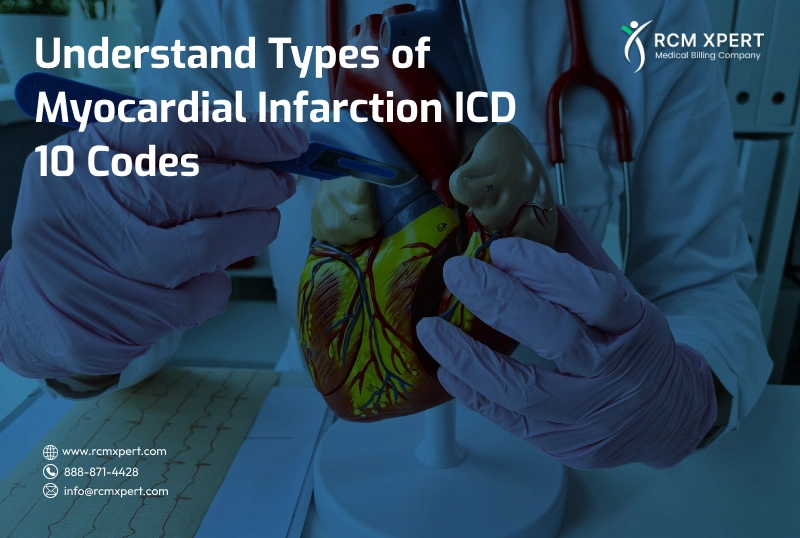Accurate ICD-10 coding is crucial for proper medical billing, especially for dangerous diseases like myocardial infarction. Coding precision not only assures proper reimbursement from insurance providers but is also essential in patient care management and health data analytics.
The importance of accurate ICD-10 coding for myocardial infarction
The ICD-10 coding system allows healthcare providers in the United States to identify and code all diagnoses, symptoms, and procedures documented during hospitalization. When it comes to myocardial infarction, the correct application of myocardial infarction icd 10 codes is crucial. These codes help in:
- Ensuring that healthcare providers receive proper reimbursement for treating myocardial infarction patients.
- Providing accurate patient records for ongoing care and future treatment initiatives.
- Improve the quality of healthcare data, which is essential to research and planning.
The Need for Myocardial Infarction ICD-10 Coding
In the field of medical billing, the accuracy of ICD-10 coding cannot be stressed, especially for illnesses like myocardial infarction. The correct use of myocardial infarction ICD-10 codes is crucial for various reasons.
- Reimbursement: Ensures that healthcare facilities are properly reimbursed for the services performed.
- Patient Care: Accurate coding aids in tracking patient outcomes and assessing therapy efficacy.
- Compliance and Reporting: Accurate coding is crucial for regulatory compliance and healthcare reporting, which affect hospital funding and licensing.
An Overview of Different Types of Myocardial Infarctions and Their Coding Relevance
Myocardial infarctions vary greatly in nature and treatment techniques, making the classification procedure complex but important. Here’s a quick overview of how different categories are represented in ICD-10 codes:
ICD-10 Coding for Types of Myocardial Infarction
| Type of Myocardial Infarction | ICD-10 Code | Description |
| Type 1 MI | I21.9 | Classic heart attack due to a primary coronary event such as a plaque rupture |
| Type 2 MI | I21.A1 | Heart attack due to ischemia from a supply and demand mismatch |
| Type 3 MI | I21.A9 | Cardiac death with symptoms suggestive of myocardial infarction |
| Type 4a MI | I21.A2 | MI associated with percutaneous coronary intervention (PCI) |
| Type 4b MI | I21.A3 | MI associated with stent thrombosis as documented by angiography or at autopsy |
| Type 5 MI | I21.A4 | MI associated with coronary artery bypass grafting (CABG) |
Why ICD-10 Myocardial Infarction Coding Matters
Understanding and using the correct ICD-10 myocardial infarction codes is crucial for:
- Avoiding Denials: Proper coding lowers the likelihood of claim denials, which can delay or prevent reimbursement.
- Clinical Decision Making: Accurate historical data supplemented by exact coding enables doctors to make better-informed decisions, potentially improving patient outcomes.
Key ICD-10 Codes for myocardial infarction
Knowing the right ICD-10 codes is essential for complete documentation and invoicing for myocardial infarction (MI). This includes a comprehensive list of these codes, with a focus on their use in different forms of MI, including the crucial distinctions required for Type 2 myocardial infarction.
Detailed ICD-10 codes for myocardial infarction
Accurate coding, according to medical billing specialists, is more than just applying the correct numerical code; it is also about understanding the clinical scenarios represented by each code. Here is a quick breakdown:
ICD-10 Codes for Different Types of Myocardial Infarction
| MI Type | ICD-10 Code | Usage Scenario |
| Type 1 MI | I21.0 – I21.3 | Used for MI resulting from a primary coronary event, typically identified by symptoms, ECG changes, and biomarkers. |
| Type 2 MI | I21.A1 | Applied when MI results from ischemia due to either increased oxygen demand or decreased supply without acute coronary syndrome. |
| Type 3 MI | I21.A9 | Used posthumously when MI leads to death before reaching the hospital and when no other cause is obvious. |
| Type 4a MI | I21.A2 | Assigned for MI related to percutaneous coronary intervention (PCI). |
| Type 4b MI | I21.A3 | Used when MI is related to stent thrombosis as confirmed by angiography or at autopsy. |
| Type 5 MI | I21.A4 | For MI occurring in the setting of coronary artery bypass graft (CABG) surgery. |
Type 1 Myocardial Infarction: Spontaneous
ICD-10 Code: I21.0 – I21.3
Type 1 myocardial infarction is caused by a main coronary event such as plaque rupture or erosion, which results in thrombosis and myocardial necrosis. This is the most prevalent form and is typically handled as an emergency.
Type 2 myocardial infarction: supply-demand mismatch
ICD-10 code: I21.A1
Type 2 myocardial infarction is caused by an imbalance between myocardial oxygen supply and demand that is not related to acute coronary thrombosis. Hypotension, anemia, and tachyarrhythmias can all contribute to this type.
Other Types of Myocardial Infarction
Type 3: Fatal Myocardial Infarction
ICD-10 Code: I21.A9
Type 3 includes cases where a myocardial infarction leads to death before biomarkers, such as troponin, can be measured.
Type 4a: Associated with Percutaneous Coronary Intervention (PCI)
ICD-10 Code: I21.A1
Occurs specifically related to PCI.
Type 4b: Stent Thrombosis
ICD-10 Code: I21.A1
This type is associated with thrombosis of a coronary artery stent.
Type 5: Associated with Coronary Artery Bypass Grafting (CABG)
ICD-10 Code: I21.A1
Occurs as a result of CABG surgery.
Understanding Myocardial Ischemia (The Silent Threat)
Myocardial ischemia is a serious condition that frequently precedes different types of myocardial infarction (MI). It happens when there is a decrease or obstruction of blood flow to a portion of the heart, usually due to restriction of the coronary arteries. This blockage causes the heart muscle to receive insufficient oxygen-rich blood, which, if sustained, can lead to cardiac damage or a heart attack.
The Role of Ischemia in Myocardial Infarction
Understanding the link between myocardial ischemia and infarction is critical for prevention and treatment. Ischemia does not usually cause noticeable signs, which is why it is commonly called a “silent” illness. Symptoms that may arise include chest pain (angina), shortness of breath, or other cardiac symptoms, especially during physical activity or stress.
Coding for Myocardial Ischemia in ICD-10
Medical billing and coding specialists must be able to recognize the correct ICD-10 codes for myocardial ischemia. It goes under multiple classifications based on its type and severity:
- I20.0 is for unstable angina.
- I20.8 for additional types of angina pectoris.
- I20.9 for angina pectoris, not defined.
- I25.1 for atherosclerotic heart disease in the native coronary artery without angina pectoris.
Accurate documentation and coding are critical to ensuring that patients receive sufficient treatment and that healthcare practitioners are properly reimbursed for their services. The difference between ischemia and myocardial infarction in medical records allows for specific treatment strategies and may save lives by preventing the progression of myocardial infarction.
Understanding the contributing factors: Analyzing the Various Types of Myocardial Infarction
Type 1: When a Blockage Sparks a Heart Attack (STEMI)
Type 1 Myocardial Infarction (STEMI) is a severe cardiac event caused by a full blockage in one of the coronary arteries. This obstruction is typically caused by plaque rupture, which forms a clot and prevents the passage of oxygen-rich blood to a major amount of the heart muscle, resulting in extensive and potentially irreversible damage.
Symptoms of STEMI
A Type 1 MI produces severe and rapid symptoms that require quick medical intervention. These symptoms may include:
- Chest pain can spread to the arms, back, neck, or jaw.
- Sweating
- Nausea
- Symptoms may include shortness of breath and overwhelming anxiety, comparable to a panic attack.
- Light-headedness or fainting
Recognizing these symptoms early is crucial for proper treatment, which frequently includes reopening the blocked artery with operations such as angioplasty and stenting.
ICD-10 codes for Type 1 MI (STEMI)
Medical billing and coding specialists must appropriately document a case of Type 1 Myocardial Infarction. The ICD-10 code for STEMI is:
I21.0: Acute transmural myocardial infarction of the anterior wall.
I21.1: Acute transmural myocardial infarction of the inferior wall.
I21.9: Acute myocardial infarction, nonspecific
The specific code used is determined by the site of the infarction, as detected by diagnostic tests such as an ECG. Proper coding is essential for not only insurance reimbursement and hospital billing, but also statistical and health management purposes.
Type 2 MI: A Supply-Demand Mismatch (NSTEMI)
Type 2 Myocardial Infarction (NSTEMI), unlike Type 1, does not necessarily involve a complete blockage of a coronary artery. Instead, it is characterized by a mismatch between the oxygen supply and demand within the heart muscle. This can be triggered by factors that either reduce blood supply, such as a coronary artery spasm, or increase oxygen demand, such as hypertension, anemia, or even physical overexertion.
Factors Contributing to NSTEMI
Common factors that can precipitate a Type 2 MI include:
- Coronary artery spasm
- Severe hypertension
- Anemia
- Tachycardia (rapid heart rate)
Symptoms of NSTEMI
The symptoms of NSTEMI are frequently weaker than those of STEMI and may even reflect other illnesses, making a precise diagnosis essential. Symptoms may include:
- Moderate chest pain or discomfort, commonly misinterpreted with indigestion.
- Dizziness
- Shortness of breath.
Healthcare practitioners must notice these symptoms and perform the necessary diagnostic procedures to confirm NSTEMI.
ICD-10 Code for Type 2 MI (NSTEMI)
The relevant ICD-10 code for Type 2 Myocardial Infarction is:
I21.A1 – Myocardial infarction type 2
Comparative Table: Type 1 MI vs. Type 2 MI
To provide a clearer understanding, below is a table summarizing the key differences between Type 1 and Type 2 Myocardial Infarctions:
| Feature | Type 1 MI (STEMI) | Type 2 MI (NSTEMI) |
| Cause | Complete blockage due to plaque rupture and thrombosis | Mismatch between oxygen supply and demand |
| Symptoms | Severe chest pain, nausea, extreme anxiety | Milder symptoms, can mimic other conditions |
| Diagnosis | ECG shows ST elevation | ECG changes less pronounced, biomarkers important |
| ICD-10 Code | I21.0, I21.1, I21.9 | I21.A1 |
ICD-10 codes for subsequent MIs include:
- I22.0: for ST elevation (STEMI) myocardial infarction of the anterior wall.
- I22.1: Subsequent ST elevation (STEMI) myocardial infarction of the inferior wall
- I22.8: Subsequent myocardial infarction at various sites
- I22.9: indicates an undetermined subsequent myocardial infarction.
Common ICD-10 Codes for Myocardial Infarction
- I21.0 – ST elevation (STEMI) myocardial infarction of anterior wall
- I21.1 – ST elevation (STEMI) myocardial infarction of inferior wall
- I21.2 – ST elevation (STEMI) myocardial infarction of other sites
- I21.3 – ST elevation (STEMI) myocardial infarction of unspecified site
- I21.4 – Non-ST elevation (NSTEMI) myocardial infarction
- I21.9 – Acute myocardial infarction, unspecified
- I21.A1 – Myocardial infarction type 2
- I21.A9 – Other myocardial infarction type
- I22.0 – Subsequent ST elevation (STEMI) myocardial infarction of anterior wall
- I22.1 – Subsequent ST elevation (STEMI) myocardial infarction of inferior wall
- I22.2 – Subsequent non-ST elevation (NSTEMI) myocardial infarction
- I22.8 – Subsequent myocardial infarction of other sites
- I22.9 – Subsequent myocardial infarction of unspecified site
Additional Codes Related to Myocardial Infarction Procedures
- I21.A2 – Myocardial infarction associated with revascularization procedures like percutaneous coronary intervention (PCI) (Type 4a)
- I21.A3 – Myocardial infarction related to stent thrombosis (Type 4b)
- I21.A4 – Myocardial infarction related to coronary artery bypass graft (CABG) (Type 5)
Final Thoughts
Overall, recognizing and applying ICD-10 codes for myocardial infarctions is crucial for improving healthcare standards and procedures. For medical practitioners, coders, and billers, the issue is not only knowing the coding but also implementing this expertise to provide holistic patient care. As we progress, the continuous updating of skills and knowledge is critical in adjusting to changing medical standards, resulting in better patient outcomes and a more effective healthcare system.














